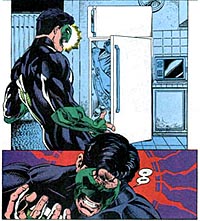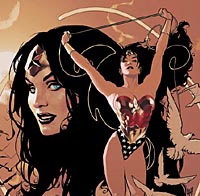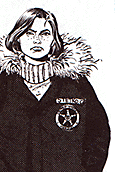>> Triple A: Urban Legend
>> Letter from the Editors
More...

Inspired by the long-running Women In Refrigerators website, Ninth Art's heavy-drinking editorial team gathered around the wine rack to discuss the role of female characters in today's comics.
ALASDAIR WATSON: Right, tell me about Women In Refrigerators. What is it?
ANDREW WHEELER: Before Gail Simone, author of KILLER PRINCESSES, DEADPOOL and NIGHT NURSE, did her humour column, You'll All Be Sorry, on Comic Book Resources, she operated a site called Women In Refrigerators. It began from the GREEN LANTERN episode in which Kyle Rayner's girlfriend is murdered by one of his enemies and crammed into his refrigerator. This was a Ron Marz story. Rayner comes home one day, opens his fridge, and finds his girlfriend squashed up inside. Gail's supposition is that women in comics are traditionally treated awfully. They get raped, they get murdered, they get dumped, abused, shunted to the side, tied up by supervillains and rescued by men. This is the fate of the woman in comics. They all end up in refrigerators.
ANTONY JOHNSTON: On the site, Gail put this supposition forward to everybody she could get in contact with who works in comics, and the site is full of responses from professionals on the subject. Many of them are very enlightening and quite well thought out.
WHEELER: It's a very good site. But is the supposition accurate? Do all women in mainstream comics end up in the refrigerator?
WATSON: Part of me feels that this is the fate of the supporting cast. As far as I'm concerned, Lois Lane is as important to the Superman books as Superman. You can't do Superman books without her. She's not supporting cast, she's main cast, in the same way as Tulip in PREACHER is, and Sue Storm in FANTASTIC FOUR.
WHEELER: So, if a woman is a mainstay of a book, she doesn't get abused?
WATSON: Not necessarily, but I don't think she necessarily gets it any worse than the male. She's going to get a different sort of a bad time to the male character, and a lot of time the shorthand for this is rape, or the suggestion of something similar.
 WHEELER: Batgirl was a prominent character, she wasn't supporting cast, and in THE KILLING JOKE she was mutilated, paralysed, and possibly raped as well.
WHEELER: Batgirl was a prominent character, she wasn't supporting cast, and in THE KILLING JOKE she was mutilated, paralysed, and possibly raped as well.
JOHNSTON: But that's Alan Moore, who has shown in other works that he's not opposed to female characters leading the book. It's not something Moore has done regularly or has shown a penchant for doing. In fact, he's shown the opposite.
WHEELER: But would [editor] Denny O'Neill's have let that be done to Batman? Would he have let him be violated?
JOHNSTON: There's an argument that Batman was violated in THE KILLING JOKE. Certainly Commissioner Gordon is. When Gail started Women In Refrigerators, it was before an era we've seen recently where more writers have instigated strong leading female characters, and in those books you won't see the female character being humiliated. You'll see her sidekicks being abused. I think that supports the notion that it is the supporting cast that suffers. But before this resurgence of female-lead books, all the lead characters were male. Therefore, if you're going to have a love interest, in an all-ages book at least, it's got to be female. What better way to get at the hero than to violate his love interest?
WHEELER: It is true to say that, until the Bad Girl came along, women were not capable of supporting a title as a lead character. With the exception of Wonder Woman, other female superheroes have not been able to support their own book for more than about three years. CATWOMAN has had to be rebooted; SHE-HULK is probably one of Marvel's biggest successes.
JOHNSTON: And that was largely a comedy book.
WHEELER: Stereotypically, female characters are supposed to be weaker, are supposed to be saved, and I think that's the stereotype Gail is accusing comics of maintaining. The traditional role of Sue Storm has been to get rescued.
'Female characters get a different sort of a bad time to male characters.' JOHNSTON: It has been there, and it is still there to an extent, but I think it's changing.
WHEELER: Because you couldn't get away with it so much these days. If you want to be respected as a creator today, you've got to give your women a fair chance.
JOHNSTON: You have to have, if not strong, then at least realistic female characters, and I don't think that's unreasonable in any medium.
WHEELER: Strong women. Which takes us to Chris Claremont. The Claremont strong woman is an archetype. His men are all weak, by comparison.
JOHNSTON: Except Wolverine, presumably. Or is Wolverine a transvestite?
WHEELER: Yes. He's a very hairy woman. But the relationships Wolverine has had have been with women who could stand up to him. Though for the most part his relationships have been sidekick relationships with kids. And not in the Batman sense. With the exception of Wolverine, Claremont's women have all been stronger, and if it came down to an argument between Wolverine and Storm, I imagine Storm would win.
WATSON: We're getting close to 'could Spider-Man beat Jesus' here.
WHEELER: No, I don't think he could. The point being, although it's become a dreadful cliché milked well beyond its death, Claremont is partly responsible for bringing women forward in comics. The Bad Girl craze owes a bit to his Psylocke. Chris Claremont's the man who invented the Hellfire Club. Selene and Emma Frost where women with incredible power, who walked around in leather corsets. And Claremont said they do this in order to subjugate men.
JOHNSTON: It gets me wondering about Claremont. Wasn't Dark Phoenix dressed in studded leather, head to toe?
WHEELER: That was the second Phoenix. But that was Claremont as well. Bondage imagery recurs constantly in Claremont's work, but the men often wore it too.
JOHNSTON: It could be said that bondage imagery started with Wonder Woman. The early Wonder Woman was often in bondage situations.
WHEELER: She wore bracelets of submission.
JOHNSTON: Trapped by her own lariat, many times.
WATSON: Today, DC is supposedly violently opposed to Wonder Woman having any kind of sexuality whatsoever.
JOHNSTON: Well, maybe not violently.
WHEELER: They won't actually beat you with sticks. Though Paul Levitz may try.
 JOHNSTON: The notion of her was sexualised in DARK KNIGHT RETURNS, and in DARK KNIGHT STRIKES AGAIN she's been overtly sexualised.
JOHNSTON: The notion of her was sexualised in DARK KNIGHT RETURNS, and in DARK KNIGHT STRIKES AGAIN she's been overtly sexualised.
WHEELER: Frank Miller always sexualises his women. You can't stop him. You've got to look at Wonder Woman's origins. She was a sado-masochistic fantasy. She was hailed by feminists because she broke the mould, but she was often being tied up, often by other women.
JOHNSTON: Wonder Woman is a very uniquely male fantasy. She was a dominatrix who inevitably ended up being dominated.
WHEELER: And let's remember William Moulton Marston was a doctor of psychology. He didn't do this without some deliberation.
JOHNSTON: It's only in the years since that people have tried to make sense of this, tried to ignore the sexuality and tried to make an actual hero out of her, and it doesn't necessarily work.
WATSON: At least two writers have wanted to put a sexual aspect to Wonder Woman, and they were told, 'No. You may hint that she has a very chaste relationship with someone who might be a boyfriend.' Which I find very odd. The superhero medium is about adolescent fantasies. Surely the image of Wonder Woman shagging is an adolescent fantasy?
JOHNSTON: DC might argue that it should stay as a fantasy.
WATSON: I'm not saying DC should show hardcore shagging on-panel.
WHEELER: At the same time, DC should probably remove the tannin from its water supply. You only need to look at THE AUTHORITY to see how unwilling they are to take a risk, even in a book that knows its audience.
JOHNSTON: OK, bad girls, post-bad girls. There are many female character-led comics out there - LADY DEATH, DARKCHYLDE, FATHOM, WITCHBLADE - and an alarming number of them have a very strong female following even though they're obviously bad girl comics.
WATSON: Well, surely 'bad girl' is better than 'boring girl'?
WHEELER: 'Bad girl' is better than 'no girl'. Where else can women go to read women written with strength, women written as being as strong as a male character? Even though they are sexual fantasy comics...
JOHNSTON: Even though they're essentially written as men with breasts...
WHEELER: ... the women are written stronger.
JOHNSTON: If you want your four-colour action comics, people like Top Cow and early Image were pretty much the only places to go for female characters who kick arse.
WATSON: Vampirella is the other one. The great classic.
'Wonder Woman is a male fantasy: a dominatrix who became dominated.' JOHNSTON: Yes. Takes no shit, dresses in a ridiculously skimpy costume, and yet is read by women.
WATSON: And VAMPIRELLA artists are often praised for being realistic. For all that her costume is outrageous and she doesn't look like a normal woman, her body parts behave like a normal woman's.
JOHNSTON: And why bother being pneumatic when her costume is so minimal? And let's not forget that when VAMPIRELLA started, back in the 50s, I believe the trend was for much more realistically shaped men and women. Even the men who were meant to be huge and muscular looked like bodybuilders, not comic book characters. And I think Vampirella has just kept up that tradition.
WHEELER: Now, Vampirella is an alien, rather than an occult creature, but are her stories occult based?
JOHNSTON: Most of them, yes. I think the alien thing was just to give the creators the excuse to set stories in fantasy worlds.
WHEELER: Because one thing that's been pointed out to me is that a lot of female characters are mystical. If you're going to have a female superhero, they're almost always from either a criminal or mystical background. They're playing off the supposed link between femininity and spirituality, but it's become a cliché. Up to and including PROMETHEA, which is at least openly stating that this is what it's doing.
JOHNSTON: It could also be because mysticism is of the mind and spirit, it neatly side-steps the issue of whether women can be physically strong enough to match up to someone like Superman.
WHEELER: How many physically powerful leading women are there? She-Hulk. After that, what is there? Other characters with the power to move an opponent, like Jean Grey and Sue Storm, their powers are mental. Psychics, mystics or former whores. Female superheroes fall very easily into a select number of 'feminine archetypes'.
JOHNSTON: But we are just talking about mainstream superheroes here. In ARCHIE comics, the women are generally always shown to be more intelligent than their male counterparts. The men are buffoons.
WHEELER: I'll be very interested to see Gail Simone's NIGHT NURSE, because although it's a comedy book, and that allows extra room to move, it is a revival, at least in name, of a classic girl comic, and it'll be interesting to see how the creator of Women In Refrigerators handles her female lead. How is she planning to hold an audience? Especially since it's not a superhero book.
 JOHNSTON: Carrie Stetko is worth mentioning.
JOHNSTON: Carrie Stetko is worth mentioning.
WHEELER: Go on then.
JOHNSTON: I shall mention Starrie Cetko...
WHEELER: No you shan't.
JOHNSTON: Carrie Stetko! Ah, the joys of alcohol. WHITEOUT's Carrie Stetko is, I think, worth mentioning because she was, for me, one of the first extremely strong and credible female lead characters I've read, post-bad girl. Carrie as a character is credible as a woman, not just as an action lead.
WHEELER: What I find remarkable about her is that Greg Rucka decided to have a female lead for no other reason than, 'why not'. A man could have been used in that story.
JOHNSTON: Yes. That character could have been a man and it wouldn't have affected the overall plot, but it did matter in terms of the subtext. Certainly the implied sexual subtext with Lilly. I think Carrie is one of the strongest and best female characters, in terms of realism, that we've seen. Rucka is quite a staunch feminist.
WHEELER: And he does enjoy writing female characters. QUEEN & COUNTRY, FELON, BLACK WIDOW. A lot of his leads are women. So, apart from female leads, the other most prominent women are the Lois Lanes, the girlfriends, the supporting cast. Have they ever been strong? Gwen Stacey was a woman in a refrigerator before the abuse of women became so cliché. I think it may be a case of people trying to replicate the impact of Gwen Stacey's death that is partly to blame for that cliché.
JOHNSTON: But I think a lot of it is simply down to expediency. If they were female characters, they would have boyfriends who would presumably be treated just as badly. But it's hard to say, because obviously that's not the case, so it hasn't happened. I can't think of any girlfriends who have been strong characters. Lois is a strong character and always has been, but she does get captured and rescued.
WHEELER: Mary Jane gets kidnapped all the time.
WATSON: Is she alive or dead at the moment?
WHEELER: I don't know. I think she might be alive. But that's classic women-in-refrigerators stuff. Killing Mary Jane is a terrible idea. That's like the clone saga all over again. And Jean Grey's been killed. Maddy Pryor is the classic spurned woman.
'Female superheroes fall easily into a select number of archetypes.' WATSON: She was the girlfriend who actually did come back and kick arse.
WHEELER: Maddy Pryor's story is the story of a woman who got rejected by her husband for a former girlfriend, and was left holding the baby. Thereafter, she turned into an evil bitch. Her story has some pathos, but it loses its way when she becomes willing to murder her own child.
WATSON: Well, it was a superhero comic, it didn't lose its way so much as it was heading that way anyway.
JOHNSTON: That does sound quite typical. She has her revenge, but she was abused first.
WHEELER: And in the end, she loses. So it's not a feminist story.
WATSON: On the other hand, at least she didn't require a man to kick arse for her. She at least does it herself.
WHEELER: One example of a book where the man in the relationship does get abused is DAREDEVIL. There the male lead is, in a sense, the boyfriend of the woman, rather than the woman being the girlfriend of the man, in that he's always getting dumped on. Admittedly his girlfriends tend to be assassins, junkies or whores...
JOHNSTON: For a lawyer, he's an amazingly bad judge of character.
WHEELER: Typhoid Mary actually ended up killing Daredevil. When she dropped him, she dropped him off a bridge. Karen Paige, I suppose, is a woman in a refrigerator, in that she did get killed in the end. And she had a really shitty time...
WATSON: But she had a shitty time at the same time that Matt Murdock was having a shitty time.
WHEELER: And in a way, in MAN WITHOUT FEAR, she rescues him as much as he rescues her. She has to come back to him before he's strong enough to fight back.
JOHNSTON: Although that does imply a certain leeching off of the woman.
WHEELER: Yes, but that was a mutually destructive, mutually dependent relationship. If the men have flaws, the women having flaws isn't so offensive.
WATSON: In DAREDEVIL, it's an equal opportunities dumping.
WHEELER: So where are things today? I think things are substantially better than when Kyle Rayner's girlfriend was shoved in the refrigerator.
JOHNSTON: I think they are, and I think they are continuing to get better. I think people are acknowledging that not only can you have female characters, but that it's actually OK to have them act realistically rather than like an ideal. We're starting to see women who are anti-heroes. I think the backlash against political correctness is here, and women no longer need to be pure, and audiences are beginning to accept that.
WHEELER: And if women aren't pure, that doesn't mean they're bad. Women are allowed to have flaws, and that doesn't make them whores. In fact, in the new CATWOMAN book, even the whores don't get written off. It's tacitly acknowledging that Catwoman used to be a prostitute, but what she has become is a guardian protector of prostitutes, and its saying prostitutes are not bad people, they're people who have fallen on bad times and are struggling. And that's actually not a radical idea for right thinking people, but for comics it seems extraordinary. In comics, the idea that prostitutes deserve to not get raped and murdered in the streets is somehow phenomenal. So maybe things are changing.

This article is Ideological Freeware. The author grants permission for its reproduction and redistribution by private individuals on condition that the author and source of the article are clearly shown, no charge is made, and the whole article is reproduced intact, including this notice.


